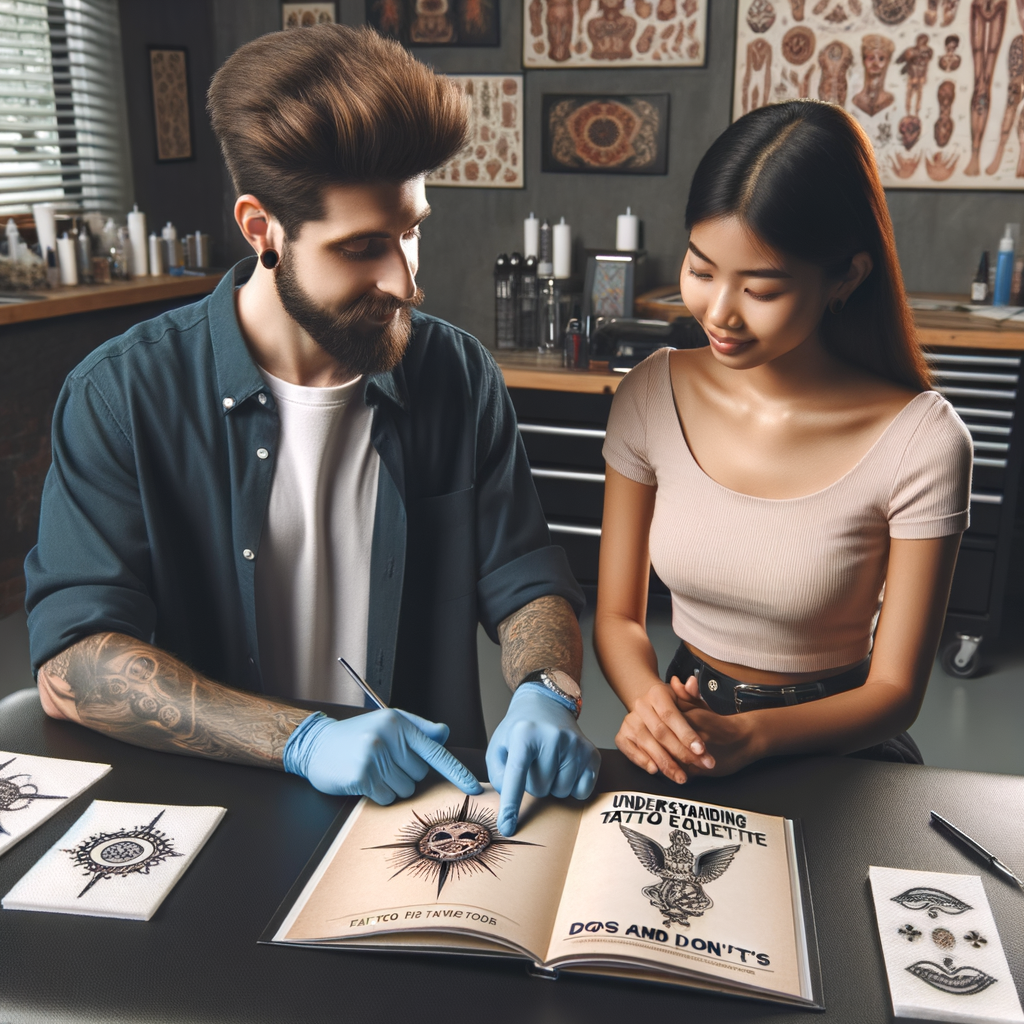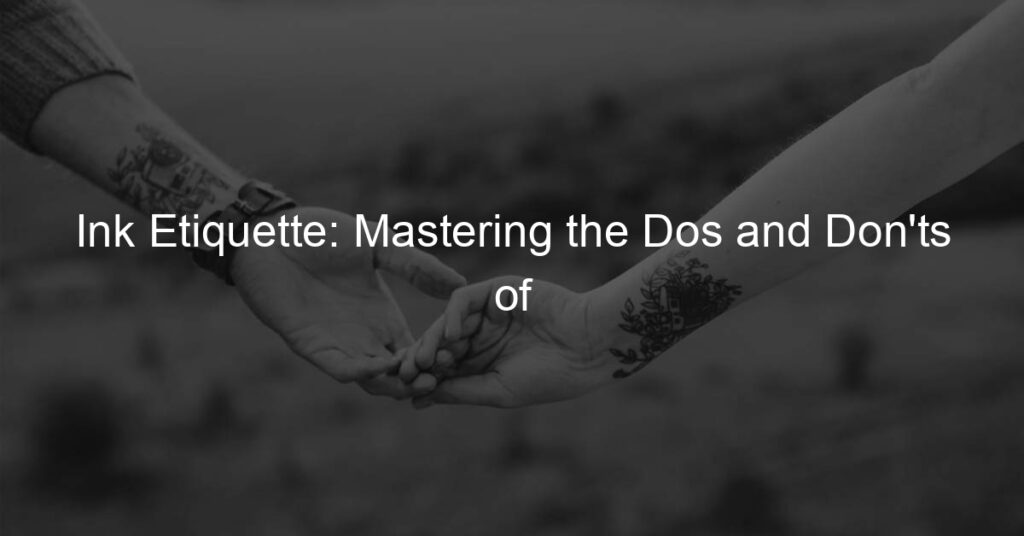
Introduction to Tattoo Etiquette
When you step into a tattoo studio, you’re not just entering a place of business. You’re stepping into a world with its own rules and traditions. Understanding tattoo etiquette is crucial to ensure a positive experience for both you and the tattoo artist. In this section, we will explore the importance of tattoo etiquette and its key elements.
-
- Understanding the Importance of Tattoo Etiquette
Tattoo etiquette is more than just good manners. It’s about respecting the art, the artist, and the process. When you show proper etiquette, you’re showing respect for the artist’s skill and dedication. You’re acknowledging that getting a tattoo isn’t just a transaction, but a unique form of self-expression. It’s also about ensuring a comfortable and safe environment for everyone involved.
-
- Key Elements of Tattoo Etiquette
There are several key elements to consider when it comes to tattoo etiquette. First, it’s important to be punctual for your appointment. This shows respect for the artist’s time. Second, it’s crucial to communicate clearly with your artist about your design ideas. This ensures that you’re both on the same page and can lead to a better final result. Lastly, proper aftercare is an essential part of tattoo etiquette. By taking care of your new tattoo, you’re showing respect for the artist’s work and ensuring that it heals properly.
In the following sections, we will delve deeper into the art of tattooing, studio etiquette, artist etiquette, and practical tips to help you navigate the world of tattoos with grace and respect.
The Art of Tattooing
Tattooing is an art form that has been practiced for centuries. It involves the insertion of ink into the skin to create permanent designs and symbols. Let’s delve into the historical context of this fascinating art form.
Historical Context
The history of tattooing is as colorful as the art itself. It has evolved over time, from ancient practices to the modern art form we know today.
-
- The Origin of Tattoos
Tattoos have been a part of human culture for thousands of years. The oldest known tattooed human skin to date is found on the body of Ötzi the Iceman, who lived around 5,300 years ago. His body, discovered in the Alps in 1991, bears 61 tattoos. These tattoos were made by making small incisions in the skin and then rubbing in charcoal.
-
- Evolution of Tattooing
The art of tattooing has evolved significantly over the centuries. In ancient times, tattoos were often symbolic, used for protection, healing, or as a mark of status. In the 18th century, Captain James Cook’s voyages to the South Pacific introduced the West to Polynesian tattooing culture, which led to a surge in its popularity.
By the late 19th and early 20th centuries, tattooing had become a mainstream practice in many parts of the world. The invention of the electric tattoo machine in the late 1800s revolutionized the process, making it quicker and less painful. Today, tattooing is recognized as a legitimate art form and means of self-expression, with countless styles and techniques.
Understanding the history of tattooing helps us appreciate the artistry and significance of this practice. As we move forward, the evolution of tattooing continues, shaped by the creativity and innovation of tattoo artists around the world.
Modern Tattoo Culture
As we delve into the world of modern tattoo culture, we’ll explore the current trends in tattooing and the significant role of tattoo etiquette. These elements shape the tattoo community and influence how we perceive and interact with this art form.
- Current Trends in Tattooing
Today’s tattoo culture is a vibrant, ever-evolving landscape. It’s not just about getting inked anymore; it’s about expressing one’s identity, telling a story, or commemorating significant life events. Let’s take a look at some of the current trends shaping this art form.
| Trend | Description |
|---|---|
| Minimalist Tattoos | These are simple, understated designs that focus on lines and shapes. They are often small and discreet, making them a popular choice for first-time tattoo recipients. |
| Watercolor Tattoos | These tattoos mimic the look of watercolor paintings with their vibrant colors and soft, blended edges. They are a beautiful way to incorporate color into a tattoo design. |
| Dotwork Tattoos | These intricate designs are created using dots instead of lines. They can range from geometric patterns to detailed portraits. |
- Role of Tattoo Etiquette in Modern Tattoo Culture
Tattoo etiquette is a set of unwritten rules that govern behavior in the tattoo community. It’s about respect – for the art, the artist, and the person getting tattooed. Here are some key aspects of tattoo etiquette:
- Respecting the Artist’s Work: This means not copying another artist’s design without permission, and trusting the artist’s expertise when it comes to placement and size.
- Personal Hygiene: Cleanliness is crucial when getting a tattoo. This includes showering before your appointment and not touching your fresh tattoo with dirty hands.
- Patience: Good tattoos take time. It’s important to be patient and not rush the artist.
Understanding and practicing tattoo etiquette helps maintain a positive environment in the tattoo community. It ensures that the process is enjoyable and respectful for everyone involved.
Tattoo Studio Etiquette
When entering a tattoo studio, it’s important to understand and follow certain etiquette rules. This not only ensures a smooth and enjoyable tattooing experience but also shows respect to the tattoo artist and their workspace.
Tattoo Appointment Dos and Don’ts
Let’s delve into the dos and don’ts when scheduling and preparing for a tattoo appointment.
-
- How to schedule a tattoo appointment
Booking a tattoo appointment is not as simple as walking into a studio and asking for a tattoo. It requires planning and communication. Here’s a simple step-by-step guide:
-
-
- Research: Look for a reputable tattoo studio and artist that specializes in the style you want.
- Contact: Reach out to the studio or artist to discuss your tattoo idea and ask any questions you may have.
- Book: Once you’re comfortable, book your appointment. Remember, some popular artists may have a waiting list.
- What to do and not do before your appointment
-
Proper preparation can make a significant difference in your tattoo experience. Here are some tips:
-
- Do:
- Eat a good meal: This helps to maintain your blood sugar levels during the session.
- Stay hydrated: Drink plenty of water before your appointment.
- Wear comfortable clothing: Choose clothes that provide easy access to the area being tattooed.
- Don’t:
- Consume alcohol or drugs: These can thin your blood and affect the tattoo process.
- Bring a crowd: Most studios prefer if you come alone or with just one support person.
- Arrive late: Respect the artist’s time and arrive a few minutes early for your appointment.
- Do:
Remember, every tattoo studio may have its own set of rules. It’s always a good idea to ask for any specific instructions when you book your appointment.
Proper Tattoo Behavior in the Studio
When you step into a tattoo studio, it’s important to remember that you’re not just there to get a tattoo. You’re entering a professional’s workspace, and your behavior should reflect that. Here are a couple of key points to keep in mind:
-
- Respecting the Tattoo Artist’s workspace
Think of a tattoo studio as an artist’s canvas. It’s a place where creativity comes to life, and it’s important to respect that. This means keeping your voice down, not touching any of the equipment, and generally keeping the area clean and tidy. Remember, the artist spends a lot of time in this space, so treat it with the same respect you would want for your own workspace.
-
- Understanding the importance of silence during the process
Getting a tattoo can be a nerve-wracking experience, and it’s natural to want to chat or ask questions to ease the tension. However, it’s important to remember that the artist needs to concentrate in order to do their best work. So, while it’s okay to talk, try to keep the conversation to a minimum and avoid asking too many questions while the artist is working. If you’re unsure about something, it’s always best to ask before the tattooing process begins.
In conclusion, proper behavior in a tattoo studio is all about respect and understanding. By respecting the artist’s workspace and understanding the importance of silence during the process, you can help to create a positive environment that allows the artist to do their best work.
Tattoo Artist Etiquette
When getting a tattoo, it’s crucial to understand and respect the etiquette involved in interacting with your tattoo artist. This includes how to communicate your design ideas and understanding the artist’s creative process.
Interacting with your Tattoo Artist
Building a good relationship with your tattoo artist can make the process smoother and more enjoyable. Here are some tips on how to do that:
-
- How to communicate your design ideas
Clear communication is key when discussing your tattoo design. Be specific about what you want, and don’t be afraid to bring in pictures or sketches. Remember, your artist is not a mind reader. The more information you provide, the better they can bring your vision to life.
-
- Understanding the artist’s creative process
Every tattoo artist has their unique creative process. Some may sketch out the design beforehand, while others may prefer to freehand the design directly onto your skin. Trust your artist’s process and remember that they are professionals with years of experience. They want to give you the best tattoo possible, so be patient and open to their suggestions.
In conclusion, understanding and respecting your tattoo artist’s etiquette is a vital part of the tattooing process. Clear communication and understanding of the artist’s creative process can lead to a better tattoo experience and a design that you love.
Tipping your Tattoo Artist
When it comes to tattoo artist etiquette, tipping is a crucial aspect that deserves our attention. Let’s delve into why it is important and how much you should tip your tattoo artist.
-
- Why tipping is important
Tipping is a way of showing your appreciation for the artist’s skill and dedication. Tattooing is a form of art, and when an artist spends hours creating a masterpiece on your skin, a tip is a small token of gratitude that goes a long way. It shows that you value their work and time. Moreover, tattoo artists often depend on tips as a significant part of their income. So, tipping not only boosts their morale but also supports them financially.
-
- How much to tip your Tattoo Artist
Deciding how much to tip can be tricky. However, a general rule of thumb is to tip between 15% to 20% of the total cost of the tattoo. If your artist went above and beyond your expectations, you might consider tipping more. Remember, there’s no upper limit to how much you can tip. It’s a personal decision based on your satisfaction with the service and your budget. However, always ensure to tip something, even if it’s small.
In conclusion, tipping your tattoo artist is an integral part of tattoo etiquette. It’s a way of expressing your satisfaction and appreciation for their work. So, next time you get a tattoo, remember to leave a tip!
Tattoo Etiquette Tips
When it comes to getting a tattoo, there are certain etiquette tips you should follow. These tips can help you have a positive tattoo experience and ensure you are respectful to your tattoo artist. Let’s explore some of these tips you should consider before getting a tattoo.
Before Getting a Tattoo
Before you decide to get a tattoo, there are a couple of important steps you should take. These steps include researching your tattoo artist and considering the placement of your tattoo.
-
- Researching your Tattoo Artist
Before you get a tattoo, it’s crucial to research your tattoo artist. This includes looking at their portfolio, reading reviews, and checking their sanitation practices. A good tattoo artist will have a clean workspace, use fresh needles for every client, and be willing to answer any questions you have about the process.
-
- Considering the placement of your Tattoo
The placement of your tattoo is another important factor to consider. Think about how visible you want your tattoo to be and how it might impact your professional life. Some workplaces have strict policies about visible tattoos. Also, remember that certain areas of the body are more sensitive than others, so choose your tattoo placement wisely.
By following these tips, you can ensure that you are prepared and respectful when you go to get your tattoo. Remember, getting a tattoo is a big decision, so it’s important to take the time to do your research and think carefully about your choices.
After Getting a Tattoo
Once you’ve gotten your tattoo, the journey doesn’t end there. There are important steps to follow to ensure your tattoo heals properly and remains vibrant. Let’s dive into the two key aspects: proper tattoo aftercare and knowing when to seek medical attention.
-
Proper Tattoo Aftercare
Aftercare is crucial to the health of your tattoo. Here are some tips:
- Keep it clean: Your tattoo is essentially a wound. Clean it gently with mild, unscented soap and water.
- Moisturize: Apply a thin layer of unscented moisturizer to your tattoo a few times a day. This helps prevent scabbing and keeps your skin hydrated.
- Avoid the sun: Sunlight can fade your tattoo and make it heal slower. Keep it covered or use a high SPF sunscreen when you’re outside.
- Don’t pick or scratch: It can be tempting, but picking or scratching at your healing tattoo can cause damage and infection.
Remember, everyone’s skin is different. What works for one person may not work for another. Listen to your body and adjust your aftercare routine as needed.
-
When to Seek Medical Attention
While it’s normal for a new tattoo to be a bit sore and red, there are signs that something might be wrong. Seek medical attention if you notice:
- Excessive redness or swelling: A little redness is normal, but if it’s severe or lasts more than a few days, it could be a sign of infection.
- Severe pain: Some discomfort is normal, but severe pain is not. If your tattoo is causing you a lot of pain, it’s time to see a doctor.
- Pus or discharge: If your tattoo is oozing pus or any other type of discharge, it’s likely infected and you should seek medical attention immediately.
- Fever: A fever can be a sign of an infection. If you have a fever along with other symptoms, see a doctor right away.
Don’t ignore these signs. It’s better to be safe than sorry when it comes to your health and your tattoo.
Tattoo Etiquette Guide: Case Studies
In this section, we will delve into real-life examples to better understand the importance of tattoo etiquette. Let’s start with a successful tattoo experience.
Case Study 1: Successful Tattoo Experience
Our first case study involves a young woman named Lisa who decided to get her first tattoo. Lisa’s experience is a perfect example of how following proper tattoo etiquette can lead to a positive outcome.
-
- How proper Tattoo Etiquette was followed:
Lisa did her research before stepping into the tattoo studio. She found a reputable artist and booked an appointment instead of walking in. On the day, she arrived on time, sober, and well-rested. She had a clear idea of what she wanted but was also open to the artist’s suggestions. Lisa made sure to communicate clearly with her artist, asking questions when she was unsure. She also respected the artist’s workspace, not touching any equipment or bringing too many friends along.
-
- Outcome of the Tattoo Experience:
The result was a beautiful piece of art that Lisa was proud to wear. The tattoo healed well, with no complications, thanks to Lisa’s diligent aftercare. The artist was also pleased with the process, appreciating Lisa’s respect and cooperation. This positive experience encouraged Lisa to return to the same artist for her future tattoos.
As we can see from Lisa’s experience, following proper tattoo etiquette not only ensures a smooth process but also fosters a respectful relationship between the client and the artist. It leads to a successful tattoo experience that leaves both parties satisfied.
Case Study 2: Unsuccessful Tattoo Experience
Let’s delve into a case where the rules of tattoo etiquette were not followed, leading to an unfortunate outcome. This case study will help us understand the importance of adhering to tattoo etiquette.
-
- Where Tattoo Etiquette was not followed
In this case, a young man named John decided to get his first tattoo. He chose a tattoo studio based solely on its proximity to his home, without researching the artist’s experience or the studio’s reputation. Upon arrival, he did not respect the personal space of the tattoo artist, constantly moving and disrupting the artist’s work. He also failed to communicate his design clearly and did not listen to the artist’s suggestions.
-
- Outcome of the Tattoo Experience
Due to John’s disregard for tattoo etiquette, the tattooing process was challenging for both him and the artist. The final tattoo was not as John had envisioned, and he was left dissatisfied with the experience. The artist also felt disrespected and frustrated. This case highlights the negative impacts of not following tattoo etiquette, both on the quality of the tattoo and the overall experience.
John’s experience serves as a reminder that tattoo etiquette is essential for a successful tattoo experience. It ensures respect for the artist’s craft and leads to a more satisfying outcome for the client. Therefore, it is crucial to research, communicate effectively, and respect the artist’s workspace when getting a tattoo.
| What Went Wrong | Impact |
|---|---|
| Lack of research about the studio and artist | Chose an unsuitable artist and studio |
| Disrespect for the artist’s personal space | Disrupted the tattooing process |
| Poor communication of desired design | Unsatisfactory final tattoo |
Understanding Tattoo Etiquette: Key Takeaways
As we wrap up our comprehensive guide on tattoo etiquette, it’s important to highlight some key takeaways. These points are not just facts to remember, but they are also integral parts of the tattoo culture that everyone should respect and adhere to.
-
- Importance of Respecting Tattoo Culture
Tattoo culture is a rich tapestry of history, art, and personal expression. It’s a community that values respect and understanding. Respecting tattoo culture means understanding the significance of different tattoo styles, acknowledging the artist’s skill and dedication, and treating the tattoo studio as a professional environment. It’s about more than just getting a tattoo; it’s about participating in a tradition that spans centuries and cultures.
-
- How Tattoo Etiquette Enhances the Tattoo Experience
Proper tattoo etiquette can significantly enhance your tattoo experience. By showing respect to the artist, the studio, and the process, you create a positive atmosphere that allows for better communication and ultimately, a better tattoo. It’s not just about getting a piece of art on your skin, it’s about the entire journey – from choosing the design and artist, to sitting in the chair, to caring for your tattoo afterwards. When you follow tattoo etiquette, you’re not just a customer, you’re part of the tattoo community.
In conclusion, understanding and respecting tattoo etiquette is crucial in enhancing your tattoo experience and showing respect to the rich culture and history of tattooing. Remember, a tattoo is not just a piece of art, it’s a commitment, a personal statement, and a part of a larger community. So, let’s respect it and treat it with the importance it deserves.






